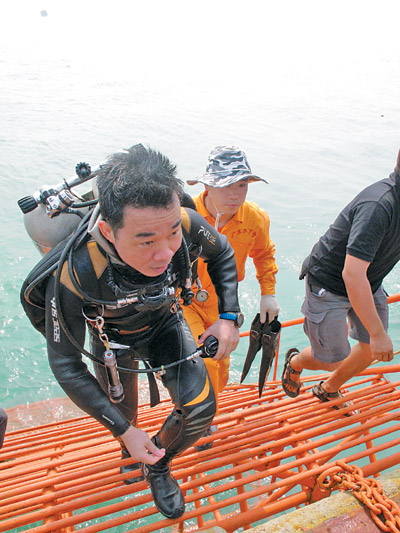Photos
Cultural relics discovered under sea
Updated: 2011-05-17 07:44
By Zhang Zixuan (China Daily)
 |
|
Diver Ruan Youhao returns to the workboat after 25 minutes performing an archaeology task at Nan'ao No 1, a merchant vessel that sank during the Ming Dynasty (1368-1644). Zhang Zixuan / China Daily |
In water vs out of it
The 2001 UNESCO Convention on the Protection of the Underwater Cultural Heritage considers in-situ preservation - in the water where it was found - to be "the first and preferred option before allowing or engaging in any activities directed at this heritage".
"Under normal circumstances, heritage is well preserved underwater owing to the low deterioration rate and lack of oxygen, and it is therefore not per se in danger," according to the convention.
"Once out of the water, the heritage will significantly lose its cultural and historical context and value," Liu said.
Damage can occur as well.
Porcelain items predominate among the artifacts found underwater and hundreds of years' immersion in seawater has made salt seep into the porcelain structure, said Zhang Huanxin, director of Fujian Museum's preservation department. Once it is exposed to air, the salt will dry and crystallize within the porcelain. The volume of the salt increases, cracking the porcelain into pieces.
"All the excavated underwater porcelain wares must be immersed again to desalt them as soon as they are taken out of the sea. But the complicated procedure may last for years," Zhang said.
China does have successful examples of in-situ preservation. In 2009, China constructed its first underwater museum, the Baiheliang Underwater Museum. However, there was no choice for underwater cultural heritage sites such as Nanhai No 1 and Nan'ao No 1. They had to be rescue-excavated to keep them from being destroyed by relic thieves.
Keeping watch
Yang Yangmei, 39, a fisherman from Qisha village, Zhangzhou, Fujian province, has been fishing for more than 25 years and he "caught" three blue-and-white porcelain bowls and a jar in his nets in September 2010. He occasionally sees illegal salvage ships now, but said that about four years ago the sightings were frequent. "Diving thieves always act at night, even in winter."
Since 2005 the public security departments of Fujian province have cracked 46 cases of illegal salvage and sale of underwater relics involving 50 criminal ships, 516 suspects and 7,372 porcelain wares.
"There were hundreds of people fishing for relics in the worst case," said Zhong Zhenyi, deputy commander of the Border Control Department of Fujian Public Security.
To better protect underwater cultural heritage sites, public security departments of coastal areas used radar, video monitors and other high-tech equipment. They also spot-check the ships that apply to enter or leave ports.
Thieves are improving their technology, too. They have created a 70-horsepower motorboat that is resistant to bullets and difficult to catch. They are also armed with GPS devices. When the police come close, they drop relics they have taken back into the sea, and use GPS to retrieve them later.
"We really feel helpless sometimes when the thieves escape right in front of us, whistling," Zhong said.
In 2007 the Yun'ao Border Control Police Station of Guangdong province volunteered to monitor Nan'ao No 1 from the day the shipwreck was found. For more than 1,400 days, 16 police officers have taken turns watching the sea surface above it from an abandoned building onshore about 3.7 km away.
"Only we know the fear at night and the loneliness when the festivals come," said Zhu Zhixiong, commander of the police station.
"No one laid a finger on the shipwreck after the last excavation, which is oddly remarkable among China's underwater shipwrecks," said Cui Yong, leader of the Nan'ao No 1 underwater archaeology team.
Expertise, cooperation
China has underwater cultural heritage protection bases in Ningbo, Qingdao and Wuhan and plans for new bases in Shanghai and Xiamen. A 580-ton professional underwater archaeology ship, the first in China, is being designed, and is estimated to go into service in 2015.
In June, the National Conservation Center for Underwater Cultural Heritage will supersede the Underwater Archaeology Research Center in hosting a sixth session of diver training. About 30 archaeology workers selected from throughout the country will train for three months at Ningbo, Xiamen and Guangzhou. The budget entry for their tailor-made diving suits is 760,000 yuan.
For the first time, the curriculum will include "law and the sense of protection to make the session more full-scale," said Liu, the center's director.
Jin Tao, 28, who works at the Ningbo Conservation Center for Underwater Cultural Heritage, Zhejiang province, trained in 2009 with the fifth batch of divers. He participated in the excavation of Nan'ao No 1 in 2010 and spent more than 100 days on the workboat.
"Most trainees now hold a master's degree or above, and they have a higher level of theoretical knowledge than those in the first few batches," Jin said. He holds a master's in archaeology from Peking University.
In November 2010 the State Administration of Cultural Heritage and the State Oceanic Administration agreed to strategic cooperation in underwater cultural heritage protection, integrating resources in underwater archaeology, underwater cultural heritage management and six other areas. Cooperation with the Public Security, Foreign Affairs and Finance ministries, the China Meteorological Administration and the navy is also under way.
"China's underwater archaeology has shifted to comprehensive underwater cultural heritage protection, and it has been expanded from coastal areas to farther reaches of the seas and inland waters," said Shan, the director of the State Administration of Cultural Heritage.
"As the travel industry and economic construction disturb the still water more often, underwater cultural heritage protection is no longer a matter of a single department, but a public obligation of everybody."
E-paper

Green works
Wuxi becomes 'test case' for facing country's environmental challenges
The global rise of Chinese brands
China-EU trade on solid ground
ZTE banks on innovation
Specials

The song dynasty
There are MORE THAN 300 types of Chinese operas but two POPULAR varieties are major standouts

Cut above the rest
One of the world's oldest surgeons has performed more than 14,000 operations

From the ground up
Architect of Guangzhou Opera House has many projects under way, including 2012 Olympics.
